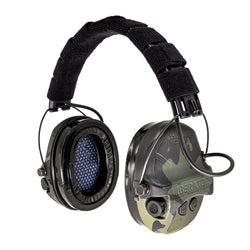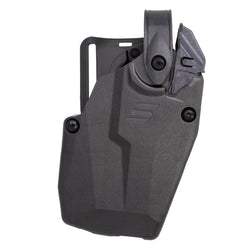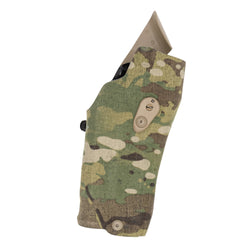In a world of unpredictable threats, the ability to quickly assess your surroundings for potential risks is a critical life skill. You don’t need a career in law enforcement or a high-priced security consultation to protect your home or other space from potential threats. But you do have to make an effort to be prepared.
Like anything else we do in life, it takes a little research, learning, practice, and vigilance. The more you focus on something, the more likely you are to be prepared when it happens.
I like to use the 2-Second Self-Defense Audit as a mental checklist. Think of it as a rapid-fire assessment of your environment’s weak points. This isn’t meant to take the place of the initial setup of your defensive plan, but rather a quick evaluation you do regularly.
Let’s look at how to apply this audit to the three places you spend the most time in. Then, we will discuss how to strategically and safely integrate self-defense tools into your preparedness plan.
Your home is your castle
For most of us, our home is our castle, and this is where we spend most of our time. Even when it feels like we’re gone a lot, most of us spend a big part of our 24-hour day at home.
Though our home is where we feel the safest, it’s frequently our most vulnerable place. If you think about it, where do you let your guard down the most and just relax? We sleep, shower, watch TV and spend time with the family at home. We assume that no one will intrude into our most personal place on earth, right?

But unfortunately, most exterior doors and residential door locks will do very little to keep out an intruder. My Grandpa used to say, “Locks only keep honest people out.” Being prepared involves more than locking a door at night before bed or when you leave the house.
To perform an audit of your home, take a walk around your property, both inside and out, and assess the following:
Entry Points
Are your exterior doors solid core or metal-clad? Do they have heavy-duty deadbolts with at least a one-inch throw? Are the door frames reinforced? A flimsy door or a weak lock is an open invitation. Consider upgrading to high-security locks and reinforcing the strike plates with longer screws that anchor into the stud frame.
I purchased a metal door reinforcement kit on Amazon, and it’s easy to install. With this kit, it will be much harder for a criminal to force the door open.

Next, check your windows. Especially on the ground floor, are they equipped with functional locks? Are they visible from the street? Windows that have shrubs covering them can provide cover for a burglar. Consider installing aftermarket window locks or security film, which makes the glass more difficult to shatter.
Sliding glass doors are notoriously bad entry points. Those little levers that lock them are easy to bump loose. Is yours secured with a bar or some kind of secondary lock?
And don’t forget about pet doors, basement windows, or access points from an attached garage. Every potential point of entry needs to be considered and secured.
Lighting and Lines of Sight
Check the perimeter of your home to see if it’s well-lit. Motion-activated floodlights are a great deterrent. Criminals like to find low-lit areas to enter a home at night. Pay special attention to the areas around doors and windows, as these are the easiest access points.
Glance at your landscape when walking around your home. Can you see your front door and windows from the street? Overgrown bushes and trees provide concealment for would-be intruders. We all like our privacy, but if a door or window is hidden from sight, a burglar will focus on that area to enter a home.

Also, pay attention to your windows at night. People often forget, if it’s dark outside and light inside, people can see right through your window. And don’t forget, you can’t see outside under these conditions either. When your lights are on at night, your windows should be covered.
Hiding Spots — Exterior and Interior
Walk around the exterior of your home to see if there are any places someone could hide, such as behind overgrown bushes or in dark spots around your home. It’s not uncommon for burglars to hide and wait for an opportunity to rob someone or break into the home.
In the unfortunate event of a break-in, where are the potential hiding spots within your home? Understanding the layout of your home from a defensive perspective is important.

I once asked someone where they would go or what they would do if their door was suddenly kicked open right now. They didn’t really know without considering it for a minute. When the unthinkable happens, you don’t have minutes. You’re lucky if you have seconds.
Home Defense Tools
When you do a home security audit, you will start to see things that could be updated or changed. Again, this doesn’t take long. It’s called a 2-second audit because that’s really all it takes. About once a month, I walk around my home to do such an audit. A quick glance as you walk is enough to see if something needs attention.
Of course, your first home audit may take a little more time as you formulate a plan. Once you have made the initial changes for home defense, however, a regular 2-second audit will help keep you sharp.
But making changes around your home is just part of a home defense plan. As you do your regular audits, you will start to see more things that could be done to increase your defense capabilities. This will no doubt lead to the consideration of self-defense tools. The key to home defense tools is safe, rapid accessibility.
Quick-Access Safes
For those who choose a firearm for home defense, a quick-access safe is a great tool to use. Some of the modern safes, like Vaultek, have biometric, keypad, and RFID access. Most of these types of safes are made to mount next to your bed or other areas of the home and hold a full-size handgun. You can retrieve the gun quickly while keeping it securely stored.

Some of these safes are even disguised as alarm clocks to help keep burglars from noticing them when you’re not home.
Firearms within reach
Using a safe is a must for many people. This will depend on your circumstances at home. But there are other ways of keeping a gun within easy access while hiding it at the same time. I like to use gun magnets to hide some of my firearms. You can place the magnet on the bottom of a desk, or anywhere suitable, and have it within easy reach.
This isn’t a good idea if you have small children who like to crawl under furniture. But most adults will never lie down to look under a coffee table for a hidden gun.

Another great option is using the Safariland QLS (quick locking system) with a holster. While this system was designed to allow holsters to be removed quickly from one platform to another, they have an unintended use. You can mount the QLS receiver plate to a wall or piece of furniture, and the holster will then lock onto it.

This still allows the gun to be accessed quickly, but adds a little more security because you can use a holster with retention to keep the gun in place.
Staging a Plate Carrier
If you want to take home defense a step further, you can stage a plate carrier somewhere in your home. For me, the bedroom is a good place. If I hear a noise in my home, there may be just enough time to throw one on as I grab my gun. A vest equipped with ballistic plates for protection can also hold other gear that may come in handy.

A typical setup might include:
- Medical Supplies: An Individual First Aid Kit (IFAK) with a tourniquet, chest seals, and bandages.
- Magazines: Spare ammunition for your chosen firearm.
- Flashlight: A good, hands-free light source is handy in some cases.
People often think that body armor is only for police or the military. But body armor is not a weapon; it is a safety device. You may not always have time to put it on, but it’s better to have the option than none at all.
The Car Security Audit
Your vehicle is a transitional space, and because of this, it has a unique set of vulnerabilities. Here’s how to conduct a quick audit of your car:
Entry Points and Visibility
Lock your doors! It may seem obvious, but a lot of people do not lock their car doors. You should always lock your doors and roll up your windows, even for a quick trip into a store.
When you first get in your car, be mindful of any valuables in plain sight. Electronics, wallet, sunglasses, or other expensive items will attract burglars. It only takes a couple of seconds to evaluate if you should put something away or remove it from the car before leaving. If you want the items to stay in your car, stick them in a compartment so they are out of sight.

Another thing to be aware of is parking. Whenever possible, park in well-lit, high-traffic areas. Avoid parking at the far end of a dark parking lot. Again, it takes a couple of seconds to evaluate parking areas based on where you are going, light conditions, cameras, and various other environmental factors. I often glance at nearby buildings and park where my car is in front of a camera. If someone does break in while I’m in the store, I want it recorded.
When you return to your car, have your keys in hand as you approach your car. Scan the area around and inside your vehicle before you unlock it. Guess how long this takes… two seconds.
Self-Defense Tools in your vehicle
Your vehicle is a small, confined space, and so your self-defense tools should accommodate that.
Some people like to carry less-lethal items in their car, like pepper spray. It’s not a good idea to try and use pepper spray to stop a violent attack, but for some, this may be the only option.
Those not old enough to own a firearm or those who travel to areas where they are not allowed on the property need some other option. A firearm is the best tool for self-defense (in my opinion), but any tool is better than none. Whatever tool you choose, make sure it is out of sight but accessible.

I carry my firearm on me, but some may need to take it off before going into certain places. If this is the case, make sure it’s out of sight from the windows and the doors are locked. As soon as you return to the vehicle, put the gun back on so you don’t forget it. Training with your firearm from a seated position is a good idea if you plan to carry a firearm in your vehicle.
The Office Security Audit
While your employer is primarily responsible for office security, you can still take proactive steps to increase your own safety.
This starts with being aware of your office’s policies for visitors. Don’t be afraid to politely question someone you don’t recognize who isn’t wearing proper identification. Often, workplace incidents will involve a current or former disgruntled employee. Take those couple of seconds to be aware of who you see. If something doesn’t look right, alert someone. Better safe than sorry.
While most fire codes require back-up lighting on exit signs, keep a flashlight at work or on your person. Some places can be very dark, even in the middle of the day when the power goes out.
Be aware of the layout of your office. Know the locations of multiple exits and potential places to shelter in the event of an emergency.
Firearms are typically prohibited in most office environments. However, there are still effective and discreet options for personal protection.

A high-quality tactical pen, made from aircraft-grade aluminum, can be a surprisingly effective impact weapon. I get it, none of us are John Wick and can’t fight like a pro with an ink pen. But again, something is better than nothing. Some employers allow employees to carry pocketknives. A good, locking knife is a great defensive tool if you don’t have access to a firearm.
In a worst-case scenario, everyday objects can be used for self-defense. A heavy pair of scissors, a fire extinguisher, or even a chair can be used to create distance and defend yourself.
A few extra seconds go a long way
It’s easy to overlook some areas of self-defense at home, in your car, or at work. The idea of a two-second audit is to develop the habit of being alert and making some quick mental notes.
You don’t have to be paranoid or spend hours worrying about a potential threat. Just take a couple of seconds to evaluate if every looks normal, or if some type of action is needed.
Once you develop a plan for each space, go over it in your head regularly to make sure you stay familiar with it. Make your environment the best landscape to help you survive during a self-defense incident.











